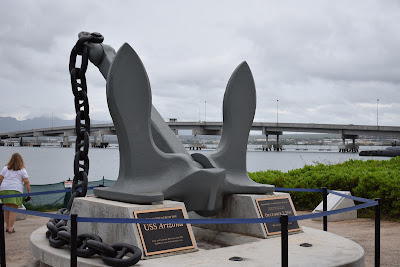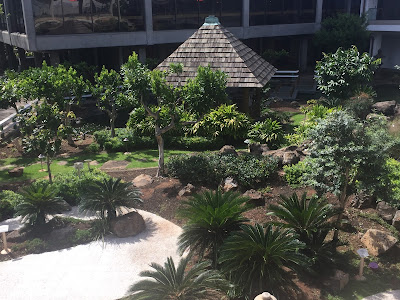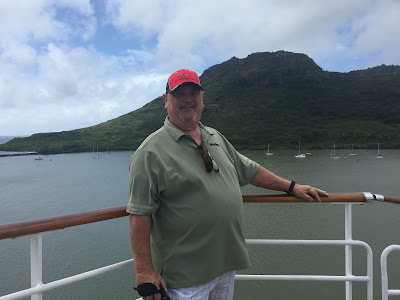Interesting stuff we learned about Hawaii.
Language
1. Learn to say Aloha! You will learn to say Aloha (Hello, Goodbye, or even I Love You) and Mahalo (Thank you) within the first 24 hours of arriving in Hawaii. You will also learn the state motto, Hang Loose, complete with a hand signal as common as a wave, hello.Make a fist. Stick out your thumb and pinkie finger and wiggle your hand. Hang Loose, You're on Hawaiian time!
2. The Hawaiian alphabet is a lot shorter than ours. The Hawaiian language is made up of 7 consonants, H, K, L, M, N, P, W and 5 vowels, A, E, I, O, U. It is a phonetic language and every vowel in a word is pronounced.
3. Hawaii is a bi-lingual state. Hawaiian was recognized in 1978 as the official native language. Listening to conversations between locals, you will hear an amalgamation of Hawaiian and English, a true blend. (Two other states are also officially bi-lingual; Louisiana--French and English, and New Mexico--Spanish and English)
History
4. There is no majority race or nationality in Hawaii since most people are a blend. Hawaii is the most isolated group of islands in the world. Rather than keeping them free from influence, they have become the world's stopping point. The islands, located in the middle of the Pacific Ocean, have been colonized and settled by Polynesians, Asians, Europeans, Africans and North Americans. Only those with actual Hawaiian ancestry are considered Hawaiian. People born and raised there, but without Hawaiian ancestry call themselves locals.
5. Hawaii has royalty--or at least it did once. King Kamehameha was the first to unite the islands under one government in 1810. It is the only state in the United States that has an official palace. The Iolani Palace in Honolulu had electricity before the White House!
Geography
6. Hawaii is bigger than you think! Hawaii has 143 islands spread over 1500 miles! Most are extinct volcanoes or atolls. Eight islands make up the main part of the state. Of those, O'ahu, Hawai'i, Kaua'i, and Maui are the most visited. Hawaii is always referred to as The Big Island.7. Honolulu is the largest city in the world? There are 4 counties in Hawaii with their own mayor and council: Hawaii, Honolulu, Kauai, Maui. According to the State Constitution, any island not named as belonging to a county belongs to Honolulu, making it the largest city in the world at 1500 miles long.
8. From East to West, Hawaii is the 2nd widest state in the United States. Alaska is the widest.
Hawaii has it's own time zone, Hawaiian Standard Time. They don't have Daylight Savings.
9. There are 3 active volcanoes in Hawaii. One, Loihi, is underground and continually growing. One day it may break the surface of the water and become a new island. The other two are on The Big Island; Mauna Loa and Kilauea. Although it is currently in the news because of the new vents opening up, Kilauea has been erupting since 1983.
10. Hawaii is still growing. The Big Island grows by 42 acres each year from the lava flows. Mauna Loa, one of the largest volcanoes in the world is also on the Big Island. It's lava fields were used as a training ground for astronauts before they went to the moon.
11. Leave the Lava!! It is considered bad luck to take lava rocks from Hawaii, according to the Legend of Pele, Hawaii's Goddess of Fire. True or not, it is true that thousands of pieces of lava rocks are mailed BACK to Hawaii each year!
12. At 10,000m tall, Mauna Kea is the tallest mountain on earth, but 6,000m of it lies beneath the ocean. However, its 4,207m above sea level makes Hawaii the second highest island in the world. (New Guinea's highest elevation is 4884m.)
13. Take a jacket. Hawaii has snow! The climate varies according to location. On one island the rainfall may be 45 inches a year in one place and 5 inches a year in another. Temperatures on the coast are warm to hot and change less than 10 degrees from daytime to nighttime, but traveling through mountains can get cold. The hottest temperature recorded was 100 degrees and the lowest was 12 degrees at the top of Mauna Kea.14. Oahu is the Rainbow Capitol of the World. Due to the frequency of short showers, brilliant rainbows abound. If you are standing at an elevation with a view, it is not uncommon to see rainbows in more than one location, at the same time.
Miscellaneous/Odd stuff--Snakes and Plastic Bags
15. Snakes and Plastic Bags have both been banned. In July 2015, Hawaii was the first state to ban plastic bags from their stores.The only snakes that can be kept are those in zoos. There is one native snake, the Island Blind Snake, but it could easily be mistaken for a worm.
A parting thought: The word Hawaii comes from a Polynesian word meaning Place of Gods, or Homeland. After visiting this beautiful place, we agree. We loved it and hope to go back.
Aloha, and Mahalo for visiting this site.
For more interesting facts, visit these websites.
http://www.travelingwiththejones.com/2012/11/12/26-fun-facts-to-know-about-hawaii/
https://www.thefactsite.com/2015/09/interesting-hawaii-facts.html
http://www.civilbeat.org/topics/endangered-species-in-hawaii/
https://www.robertshawaii.com/blog/legend-behind-hawaiis-goddess-fire/






















































































